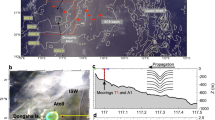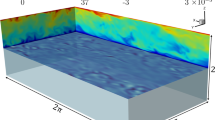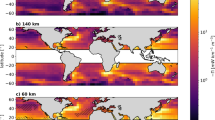Abstract
Breaking ocean waves entrain air bubbles that enhance air–sea gas flux, produce aerosols, generate ambient noise and scavenge biological surfactants. The size distribution of the entrained bubbles is the most important factor in controlling these processes, but little is known about bubble properties and formation mechanisms inside whitecaps. We have measured bubble size distributions inside breaking waves in the laboratory and in the open ocean, and provide a quantitative description of bubble formation mechanisms in the laboratory. We find two distinct mechanisms controlling the size distribution, depending on bubble size. For bubbles larger than about 1 mm, turbulent fragmentation determines bubble size distribution, resulting in a bubble density proportional to the bubble radius to the power of -10/3. Smaller bubbles are created by jet and drop impact on the wave face, with a -3/2 power-law scaling. The length scale separating these processes is the scale where turbulent fragmentation ceases, also known as the Hinze scale. Our results will have important implications for the study of air–sea gas transfer.
This is a preview of subscription content, access via your institution
Access options
Subscribe to this journal
Receive 51 print issues and online access
$199.00 per year
only $3.90 per issue
Buy this article
- Purchase on Springer Link
- Instant access to full article PDF
Prices may be subject to local taxes which are calculated during checkout






Similar content being viewed by others
References
Lamarre, E. & Melville, W. K. Air entrainment and dissipation in breaking waves. Nature 351, 469–472 (1991)
Wallace, D. W. R. & Wirick, C. D. Large air–sea fluxes associated with breaking waves. Nature 356, 694–696 (1992)
Farmer, D. M., McNeil, C. L. & Johnson, B. D. Evidence for the importance of bubbles in increasing air–sea gas flux. Nature 361, 620–623 (1993)
Melville, W. K. The role of surface-wave breaking in air-sea interaction. Annu. Rev. Fluid. Mech. 28, 279–321 (1996)
Thorpe, S. A. The effect of Langmuir circulation on the distribution of submerged bubbles caused by breaking wind waves. J. Fluid. Mech. 142, 151–170 (1984)
Medwin, H. & Breitz, N. D. Ambient and transient bubble spectral densities in quiescent seas and under spilling breakers. J. Geophys. Res. 94, 12751–12759 (1989)
Hwang, P. A., Hsu, Y. L. & Wu, J. Temperature effects on generation and entrainment of bubbles induced by a water jet. J. Phys. Oceanogr. 20, 19–28 (1990)
Monahan, E. C. & Lu, M. Acoustically relevant bubble assemblages and their dependence on meteorological parameters. IEEE J. Ocean. Eng. 15, 340–349 (1990)
Thorpe, S. A. Bubble clouds and the dynamics of the upper ocean. Q. J. R. Meteorol. Soc. 118, 1–22 (1992)
Thorpe, S. A., Bowyer, P. & Woolf, D. K. Some factors affecting the size distributions of oceanic bubbles. J. Phys. Oceanogr. 22, 382–389 (1992)
Farmer, D. & Li, M. Patterns of bubble clouds organized by Langmuir circulation. J. Phys. Oceanogr. 25, 1426–1440 (1995)
Bezzabotnov, V. S., Bortkovskiy, R. S. & Timanovskiy, D. F. On the structure of the two-phase medium generated at wind-wave breaking. Izvest. Atmos. Ocean. Phys. 22, 922–928 (1986)
Deane, G. B. & Stokes, M. D. Air entrainment processes and bubble size distributions in the surf zone. J. Phys. Oceanogr. 29, 1393–1403 (1998)
Stokes, M. D., Deane, G. B., Vagle, S. & Farmer, D. in Gas Transfer at Water Surfaces Geophysical Monographs 127 (eds Donelan, M. A., Drennan, W. M., Saltzman, E. S. & Wanninkhof, R.) 278–285 (American Geophysical Union, Washington, DC, 2002)
de Leeuw, G. D. & Cohen, L. H. in Gas Transfer at Water Surfaces Geophysical Monographs 127 (eds Donelan, M. A., Drennan, W. M., Saltzman, E. S. & Wanninkhof, R.) 271–277, (American Geophysical Union, Washington, DC, 2002)
Longuet-Higgins, M. S. The crushing of air cavities in a liquid. Proc. R. Soc. Lond. A 439, 611–626 (1992)
Baldy, S. A generation-dispersion model of ambient and transient bubbles in the close vicinity of breaking waves. J. Geophys. Res. 98, 18277–18293 (1993)
Garrett, C., Li, M. & Farmer, D. The connection between bubble size spectra and energy dissipation rates in the upper ocean. J. Phys. Oceanogr. 30, 2163–2171 (2000)
Van De Sande, E. & Smith, J. M. Jet break-up and air entrainment by low velocity turbulent water jets. Chem. Eng. Sci. 31, 219–224 (1976)
Bonetto, F. & Lahey, R. T. Jr An experimental study on air carryunder due to a plunging jet. Int. J. Multiphase Flow 19, 281–294 (1993)
Pumphrey, H. C. & Elmore, P. A. The entrainment of bubbles by drop impacts. J. Fluid Mech. 220, 539–567 (1990)
Koga, M. Bubble entrainment in breaking wind waves. Tellus 34, 481–489 (1982)
Loewen, M. R., O'Dor, M. A. & Skafel, M. G. Bubbles entrained by mechanically generated breaking waves. J. Geophys. Res. 101, 20759–20820 (1996)
Bonmarin, P. Geometric properties of deep water breaking waves. J. Fluid Mech. 209, 405–433 (1989)
Minnaert, M. On musical air bubbles and the sounds of running water. Phil. Mag. 16, 235–248 (1933)
Leighton, T. G. The Acoustic Bubble (Academic, San Diego, 1994)
Stokes, M. D. & Deane, G. B. A new optical instrument for the study of breaking waves at high void fractions within breaking waves. IEEE J. Ocean. Eng. 24, 300–311 (1999)
Kolomogorov, A. N. O droblenii kapel' v turbulentnom potoke. Dokl. Acad. Nauk USSR 66, 825–828 (1949)
Hinze, J. O. Fundamentals of the hydrodynamic mechanism of slitting in dispersion processes. J. Am. Inst. Chem. Eng. 1, 289–295 (1955)
Lewis, D. A. & Davidson, J. F. Bubble splitting in shear flow. Trans. Inst. Chem. Eng. 60, 283–291 (1982)
Martínez-Bazán, C., Montañés, J. L. & Lasheras, J. C. On the breakup of an air bubble injected into a fully developed turbulent flow. I. Breakup frequency. J. Fluid Mech. 401, 157–182 (1999)
Fan, L.-S. & Tsuchiya, K. Bubble Wake Dynamics in Liquids and Liquid-Solid Suspensions (Butterworth-Heinemann, Boston, 1990)
Clay, P. H. The mechanism of emulsion formation in turbulent flow: theoretical part and discussion. Proc. R. Acad. Sci. 43, 979–990 (1940)
Loewen, M. R. & Melville, W. K. Microwave backscatter and acoustic radiation from breaking waves. J. Fluid Mech. 224, 601–623 (1991)
Deane, G. B. Sound generation and air entrainment by breaking waves in the surf zone. J. Acoust. Soc. Am. 102, 2671–2689 (1997)
Loewen, M. R., O'Dor, M. A. & Skafel, M. G. in Third Int. Symp. on Air-Water Gas Transfer (eds Jahne, B. & Monahan, E. C.) 337–349 (AEON Verlag & Studio, Hanau, Germany, 1995)
Loewen, M. R. & Melville, W. K. An experimental investigation of the collective oscillations of bubble plumes entrained by breaking waves. J. Acoust. Soc. Am. 95, 1329–1343 (1992)
Acknowledgements
We thank G. Devine and J. Uyloan for assistance in laboratory data analysis, and the crew of RP FLIP during oceanic deployments. We also thank D. Farmer, M. Li and C. Garrett for discussions. This work was supported by the National Science Foundation and the Office of Naval Research.
Author information
Authors and Affiliations
Corresponding author
Ethics declarations
Competing interests
The authors declare that they have no competing financial interests.
Rights and permissions
About this article
Cite this article
Deane, G., Stokes, M. Scale dependence of bubble creation mechanisms in breaking waves. Nature 418, 839–844 (2002). https://doi.org/10.1038/nature00967
Received:
Accepted:
Issue Date:
DOI: https://doi.org/10.1038/nature00967
This article is cited by
-
Cavitation research with computational fluid dynamics: From Euler-Euler to Euler-Lagrange approach
Journal of Hydrodynamics (2024)
-
The interaction of droplet dynamics and turbulence cascade
Communications Physics (2023)
-
On the Influence of Microbubbles on the Turbulence Induced by a Surface Wave
Radiophysics and Quantum Electronics (2023)
-
Free surface aeration and development dependence in chute flows
Scientific Reports (2022)
-
Massive production of fibroin nano-fibrous biomaterial by turbulent co-flow
Scientific Reports (2022)
Comments
By submitting a comment you agree to abide by our Terms and Community Guidelines. If you find something abusive or that does not comply with our terms or guidelines please flag it as inappropriate.



